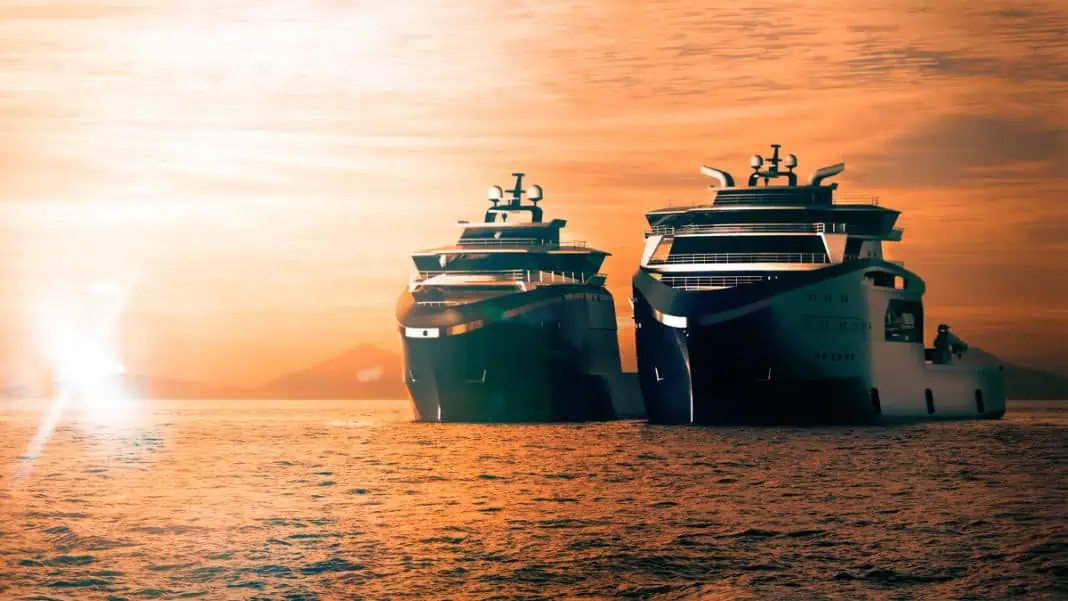Kongsberg Maritime has today unveiled a new range of ship designs in its extensive UT Design portfolio. The new anchor handler (AHT) and platform supply vessels (PSV) have the option to include alternative energy sources and fuels, such as methanol, ammonia, and hybrid-battery power.
Kongsberg has been a leader in the design of PSV and AHT vessels for 50 years, with hundreds in service globally. The next generation designs for both platform supply and anchor handler share a range of innovations to help ship owners address current and future challenges around efficiency, emissions reduction and developing market requirements.
The AHT and PSV designs have received Approval in Principle from class society DNV to operate with ammonia-fuelled engines and they can incorporate an offshore charging capable plug-in hybrid option, to enable emission-free battery-powered operation.
Einar Vegsund, Director, Ship Design Solutions, Kongsberg Maritime, said: “Kongsberg’s iconic UT vessels have been the benchmark design for the offshore industry for the past 50 years. These latest designs combine decades of experience and the latest innovative Kongsberg technologies to offer customers next-generation ships that are equipped for the future.
“Our ship designs continue to evolve, and changes to regulations and uncertainty around preferred fuels have driven the demand to create ships that are ready for the future and give owners the confidence to invest, knowing their ships can adapt to meet future requirements.”
Martijn de Jongh, Chief Designer Specialised Vessels, Kongsberg Maritime, added: “A great deal of work has gone into ensuring this new range of ships gives owners a reduction in environmental footprint. We have drawn on the results of numerous R&D programmes including hydrodynamic optimisation, assessing offshore battery charging and in cooperation with Amon Maritime, obtained the Approval in Principle for the use of ammonia as a fuel.
“One of the great innovations the anchor handler design offers is significantly reduced energy consumption during anchor operations. This is achieved through the use of Kongsberg’s cross-tensioning system where the load testing of anchors will use the power of the winches rather than the traditional approach of one or more vessels using bollard pull and engine power. This approach will lead to significant operational cost savings, enabling this crucial offshore task to be handled by a single ship”.
The anchor handler range, known as UT 7800, will eventually include four sizes, ranging from small to extra-large, with bollard pulls of 180 tons for the small version, increasing to over 400 tons for the largest version of the ship.
Martijn de Jongh adds: “The UT 7800 has been designed for initial operation in the traditional oil and gas anchor handling market, but it is very adaptable for future offshore energy developments, such as floating wind. While we are also designing ships specifically for the offshore wind market, the UT 7800 range has the benefit of being able operate at first in oil and gas, then, if desired, it can be adapted to serve operations in new, evolving markets.”
Kongsberg offers a choice of winch configurations and capacities, as well as adaptable chain and rope handling and storage capacity. ROVs and cranes can also be integrated into the designs. For the largest vessels, the deck equipment and arrangement has been optimised for the larger dimensions and weights of the rope, chain and equipment than is typical within oil and gas, enabling operations outside these traditional markets.
Today there are hundreds of Kongsberg designed platform supply vessels in operation around the world. The new PSV design range (UT 7400) has all the necessary features to address the latest regulations for the transport of the liquid products and the growing requirement for lower emissions and environmental footprint, including energy consumption reduction, and readiness for future fuel transition.
The Kongsberg PSV range of designs comes with a variety of options for the type of cargo, cargo volume and cargo deck area, which can be configured depending on the operational profile of the vessel. The cargo area has been re-designed and provides options for the various products compliant with the latest OSV Chemical Code regulations, ensuring the safe transportation and storage of hazardous materials, while optimising the structural arrangement.












